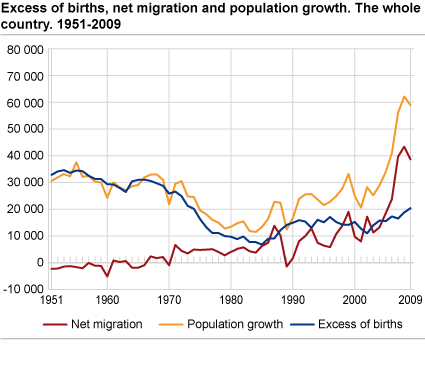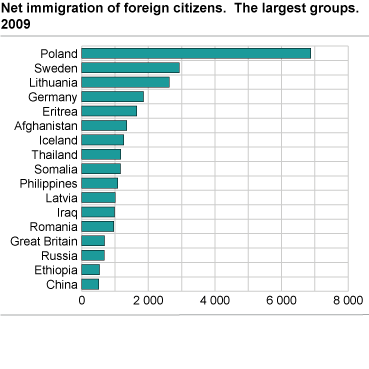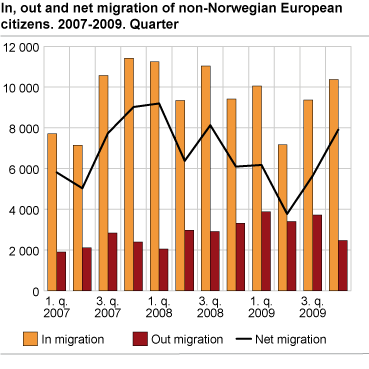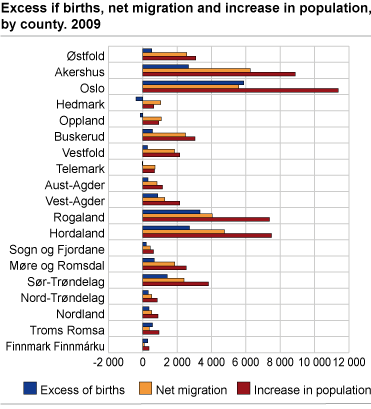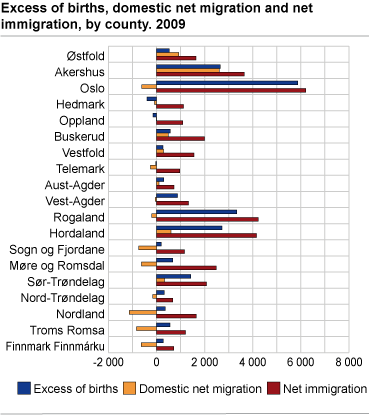Content
Published:
This is an archived release.
Highest number of births in 37 years
Norway's population increased by 58 950 to 4 858 200 in 2009. The birth surplus contributed to 35 per cent of the population increase, whereas the migration surplus from abroad contributed to 65 per cent. Not since 1972 have more children been born in Norway than in 2009.
The relative population increase was 1.2 per cent in 2009. Since 1900, only three years have had a higher relative increase than 2009; 1920, 1946 and 2008.
Immigration totalled 65 200 in 2009, which is 1 800 less than in the previous year. Emigration increased by 2 900, totalling 26 550. Births totalled 61 800 in 2009 and total deaths was 41 450.
|
The population as at 1 January 2010 is published by sex and age. Figures for municipalities, counties and the country as a whole, distributed by one-year age groups and sex, are available in StatBank Norway. Furthermore, tables containing figures by sex and different age groups for municipalities, counties and the country as a whole are available at http://www.ssb.no/folkemengde/ . More data will be published on 11 March. The total numbers for births, deaths and migrations in 2009 are available for municipalities, counties and the whole country. Figures for migration by citizenship are available on request. More detailed statistics on deaths, births, internal migrations, and immigration and emigration will be published on 8 April, 15 April and 6 May respectively. Figures are now published for marriages, divorces and separations for counties and the whole country. These are available at http://www.ssb.no/ekteskap/ . More detailed information on these topics will be available in August. |
20 350 more births than deaths - total fertility rate at 1.98
Last year, 61 800 children were born in Norway and 41 450 persons died. The number of children born is the highest since 1972, and not since around 1980 has the number of deaths been lower than during the period 2004-2009. The resulting excess of births of 20 350 has not been higher since 1973.
The total fertility rate for 2009 was 1.98. This is among the highest in Europe. In the mid-1980s the rate varied between 1.66 and 1.75.
A boy born in 2009 can expect a life duration of 78.60 years, and a girl can expect 83.05 years. Both are slightly up from 2008, and high compared to the rest of Europe.
Poles still largest group of immigrants
Compared to 2008, net immigration surplus decreased by 4 700 to 38 600. Polish citizens contributed most to the surplus, with 6 900 more immigrations than emigrations last year. They were followed by Swedes and Lithuanians, with a net immigration of 2 900 and 2 600 respectively. Whereas for the most part there were no great changes in the figures from 2008 to 1009, net immigration of Polish and German citizens was reduced by close to 50 per cent.
Considerable changes from quarter to quarter
In- and out-migration by European citizens changed considerably quarter by quarter 2009, compared to the corresponding quarters in 2008. In-migration started decreasing during the 4t h quarter 2008, and this continued during the first three quarters 2009, but showed an increase in the last quarter of 2009. The out-migration showed a reverse pattern. The resulting decrease of net migration by Europeans by some 3 000 during the first quarters, therefore turned into an increase by some 1 800 during the last quarter.
Highest natural increase in Oslo
As in later years, there was an excess of births over deaths in all counties except Hedmark, Oppland and Telemark. The highest natural increase took place in Oslo, with 5 900 more births than deaths.
Oslo, Akershus, Rogaland and Hordaland had the largest population increase in 2009, with 60 per cent of the total national increase. In Oslo and Akershus the increase was 3 800 lower than in 2008, whereas Rogaland and Hordaland experienced a similar growth as in 2008.
Migration gain from abroad
As in previous years, all 19 counties had a migration gain from abroad. Oslo had the largest gain with 6 200, down from 10 000 in 2008. The migration gain totalled 38 600 and offset the birth deficit and domestic migration loss in many counties.
Population increase in 300 municipalities
A total of 300 municipalities (of Norway’s 430 municipalities) had a population increase in 2009, whereas 119 had a decrease. In 2008, 269 municipalities had an increase. Of the 42 municipalities with a decrease of 1 per cent or more, 22 were situated in Northern Norway. As in previous years, the centrally situated municipalities had population increases, whereas the less central areas had migration loss as well as birth deficits. Of the 15 municipalities with an excess of births over deaths of 1 per cent or more, 7 were situated in Rogaland. On the other hand, of the 25 municipalities with the largest birth deficit, 13 were in Hedmark and Oppland.
| Total migration gain (324 in all) | Domestic migration gain (162 in all) | Migration gain from abroad (414 in all) | |||||||||||||||||||||||||||||||||||||||||||||||||||||||||||||||||||||||||||||
|---|---|---|---|---|---|---|---|---|---|---|---|---|---|---|---|---|---|---|---|---|---|---|---|---|---|---|---|---|---|---|---|---|---|---|---|---|---|---|---|---|---|---|---|---|---|---|---|---|---|---|---|---|---|---|---|---|---|---|---|---|---|---|---|---|---|---|---|---|---|---|---|---|---|---|---|---|---|---|---|
| 1 | Oslo | 5 587 | Bergen | 905 | Oslo | 6 207 | |||||||||||||||||||||||||||||||||||||||||||||||||||||||||||||||||||||||||
| 2 | Bergen | 2 974 | Ullensaker | 495 | Bergen | 2 069 | |||||||||||||||||||||||||||||||||||||||||||||||||||||||||||||||||||||||||
| 3 | Trondheim | 1 403 | Skedsmo | 400 | Stavanger | 1 580 | |||||||||||||||||||||||||||||||||||||||||||||||||||||||||||||||||||||||||
| 4 | Stavanger | 1 254 | Fredrikstad | 335 | Trondheim | 1 370 | |||||||||||||||||||||||||||||||||||||||||||||||||||||||||||||||||||||||||
| 5 | Bærum | 975 | Drammen | 285 | Sandnes | 724 | |||||||||||||||||||||||||||||||||||||||||||||||||||||||||||||||||||||||||
| 6 | Drammen | 907 | Bærum | 260 | Bærum | 715 | |||||||||||||||||||||||||||||||||||||||||||||||||||||||||||||||||||||||||
| 7 | Skedsmo | 784 | Sola | 236 | Kristiansand | 652 | |||||||||||||||||||||||||||||||||||||||||||||||||||||||||||||||||||||||||
| 8 | Fredrikstad | 734 | Stjørdal | 226 | Drammen | 622 | |||||||||||||||||||||||||||||||||||||||||||||||||||||||||||||||||||||||||
| 9 | Ullensaker | 711 | Halden | 206 | Asker | 443 | |||||||||||||||||||||||||||||||||||||||||||||||||||||||||||||||||||||||||
| 10 | Kristiansand | 705 | Sørum | 204 | ålesund | 419 | |||||||||||||||||||||||||||||||||||||||||||||||||||||||||||||||||||||||||
| Total migration loss (99 in all) | Domestic migration loss (261 in all) | Migration loss to abroad (10 in all) | |||||||||||||||||||||||||||||||||||||||||||||||||||||||||||||||||||||||||||||
|---|---|---|---|---|---|---|---|---|---|---|---|---|---|---|---|---|---|---|---|---|---|---|---|---|---|---|---|---|---|---|---|---|---|---|---|---|---|---|---|---|---|---|---|---|---|---|---|---|---|---|---|---|---|---|---|---|---|---|---|---|---|---|---|---|---|---|---|---|---|---|---|---|---|---|---|---|---|---|---|
| 1 | Høyanger | -67 | Oslo | -620 | Marnardal | -4 | |||||||||||||||||||||||||||||||||||||||||||||||||||||||||||||||||||||||||
| 2 | Bardu | -67 | Stavanger | -326 | Selje | -4 | |||||||||||||||||||||||||||||||||||||||||||||||||||||||||||||||||||||||||
| 3 | Guovdageaidnu Kautokeino | -57 | Narvik | -130 | Lom and | -3 | |||||||||||||||||||||||||||||||||||||||||||||||||||||||||||||||||||||||||
| 4 | Flakstad | -43 | Flora | -129 | Namdalseid | -3 | |||||||||||||||||||||||||||||||||||||||||||||||||||||||||||||||||||||||||
| 5 | Selje | -42 | Bardu | -128 | Bjarkøy | -3 | |||||||||||||||||||||||||||||||||||||||||||||||||||||||||||||||||||||||||
| 6 | Lødingen | -40 | Voss | -124 | Granvin | -2 | |||||||||||||||||||||||||||||||||||||||||||||||||||||||||||||||||||||||||
| 7 | Rana | -39 | Harstad | -124 | Flå | -1 | |||||||||||||||||||||||||||||||||||||||||||||||||||||||||||||||||||||||||
| 8 | Vestvågøy | -39 | Alta | -124 | Modalen and | -1 | |||||||||||||||||||||||||||||||||||||||||||||||||||||||||||||||||||||||||
| 9 | Enebakk | -37 | Farsund | -122 | Rindal and | -1 | |||||||||||||||||||||||||||||||||||||||||||||||||||||||||||||||||||||||||
| 10 | Gol and Gildeskål | -37 | Vadsø | -121 | Evenes | -1 | |||||||||||||||||||||||||||||||||||||||||||||||||||||||||||||||||||||||||
| Excess of births (224 in total) |
Excess of births in relation to population /
1 000 (224 in total) (Norway = 4.24) |
Population growth (300 in total) |
Population growth in relation to population /
1 000 (300 in total) (Norway = 12.28) |
||||||||||||||||||||||||||||||||||||||||||||||||||||||||||||||||||||||||||||
|---|---|---|---|---|---|---|---|---|---|---|---|---|---|---|---|---|---|---|---|---|---|---|---|---|---|---|---|---|---|---|---|---|---|---|---|---|---|---|---|---|---|---|---|---|---|---|---|---|---|---|---|---|---|---|---|---|---|---|---|---|---|---|---|---|---|---|---|---|---|---|---|---|---|---|---|---|---|---|---|
| 1 | slo | 5 871 | Rennesøy | 13.4 | Oslo | 11 385 | Træna | 74.7 | |||||||||||||||||||||||||||||||||||||||||||||||||||||||||||||||||||||||
| 2 | Bergen | 1 573 | Klepp | 12.9 | Bergen | 4 549 | Austrheim | 62.9 | |||||||||||||||||||||||||||||||||||||||||||||||||||||||||||||||||||||||
| 3 | Trondheim | 1 279 | Førde | 12.3 | Trondheim | 2 679 | Ulstein | 58.0 | |||||||||||||||||||||||||||||||||||||||||||||||||||||||||||||||||||||||
| 4 | Stavanger | 1 004 | Hå | 12.1 | Stavanger | 2 240 | Hemsedal | 46.1 | |||||||||||||||||||||||||||||||||||||||||||||||||||||||||||||||||||||||
| 5 | Sandnes | 596 | Guovdageaidnu Kautokeino | 11.8 | Bærum | 1 513 | Gjerdrum | 45.6 | |||||||||||||||||||||||||||||||||||||||||||||||||||||||||||||||||||||||
| 6 | Tromsø | 548 | Sund | 11.4 | Sandnes | 1 240 | Rennesøy | 37.8 | |||||||||||||||||||||||||||||||||||||||||||||||||||||||||||||||||||||||
| 7 | Bærum | 538 | Sola | 11.1 | Kristiansand | 1 186 | Austevoll | 34.9 | |||||||||||||||||||||||||||||||||||||||||||||||||||||||||||||||||||||||
| 8 | Kristiansand | 483 | Askøy | 10.8 | Drammen | 1 161 | Klepp | 34.7 | |||||||||||||||||||||||||||||||||||||||||||||||||||||||||||||||||||||||
| 9 | Bodø | 383 | Tysvær | 10.3 | Skedsmo | 1 055 | Sola | 34.2 | |||||||||||||||||||||||||||||||||||||||||||||||||||||||||||||||||||||||
| 10 | Asker | 281 | Oslo and Birkenes | 10.2 | Ullensaker | 950 | Ullensaker | 33.8 | |||||||||||||||||||||||||||||||||||||||||||||||||||||||||||||||||||||||
| Birth deficit (196 in total) |
Birth deficit in relation to population /
1 000 (196 in total) |
Population decrease (119 in total) |
Population decrease in relation to population /
1 000 (119 in total) |
||||||||||||||||||||||||||||||||||||||||||||||||||||||||||||||||||||||||||||
|---|---|---|---|---|---|---|---|---|---|---|---|---|---|---|---|---|---|---|---|---|---|---|---|---|---|---|---|---|---|---|---|---|---|---|---|---|---|---|---|---|---|---|---|---|---|---|---|---|---|---|---|---|---|---|---|---|---|---|---|---|---|---|---|---|---|---|---|---|---|---|---|---|---|---|---|---|---|---|---|
| 1 | Kongsvinger | -62 | Ibestad | -20.1 | Høyanger | -71 | Bjarkøy | -41.7 | |||||||||||||||||||||||||||||||||||||||||||||||||||||||||||||||||||||||
| 2 | åsnes | -55 | Snillfjord | -16.2 | Eidskog | -67 | Hasvik | -37.1 | |||||||||||||||||||||||||||||||||||||||||||||||||||||||||||||||||||||||
| 3 | Eidskog | -46 | Rendalen | -14.9 | Lødingen | -61 | Flakstad | -35.2 | |||||||||||||||||||||||||||||||||||||||||||||||||||||||||||||||||||||||
| 4 | Grue | -45 | Bø i Nordland | -14.4 | Sunndal | -58 | Måsøy | -32.1 | |||||||||||||||||||||||||||||||||||||||||||||||||||||||||||||||||||||||
| 5 | Odda | -45 | Flatanger | -12.3 | Gildeskål | -57 | Mosvik | -31.1 | |||||||||||||||||||||||||||||||||||||||||||||||||||||||||||||||||||||||
| 6 | Stange | -42 | Steigen | -12.0 | Selje | -53 | Gildeskål | -27.8 | |||||||||||||||||||||||||||||||||||||||||||||||||||||||||||||||||||||||
| 7 | Bø | -41 | Bjarkøy | -11.9 | Flakstad | -50 | Kvitsøy | -27.7 | |||||||||||||||||||||||||||||||||||||||||||||||||||||||||||||||||||||||
| 8 | Trysil | -40 | Moskenes | -11.6 | Bø | -49 | Lødingen | -27.2 | |||||||||||||||||||||||||||||||||||||||||||||||||||||||||||||||||||||||
| 9 | Sunndal | -38 | Halsa | -11.5 | Steigen | -46 | Flatanger | -26.5 | |||||||||||||||||||||||||||||||||||||||||||||||||||||||||||||||||||||||
| 10 | Steigen | -32 | Solund | -11.4 | Surnadal | -44 | Ibestad | -22.2 | |||||||||||||||||||||||||||||||||||||||||||||||||||||||||||||||||||||||
The statistics is published with Population.
Contact
-
Statistics Norway's Information Centre
E-mail: informasjon@ssb.no
tel.: (+47) 21 09 46 42

